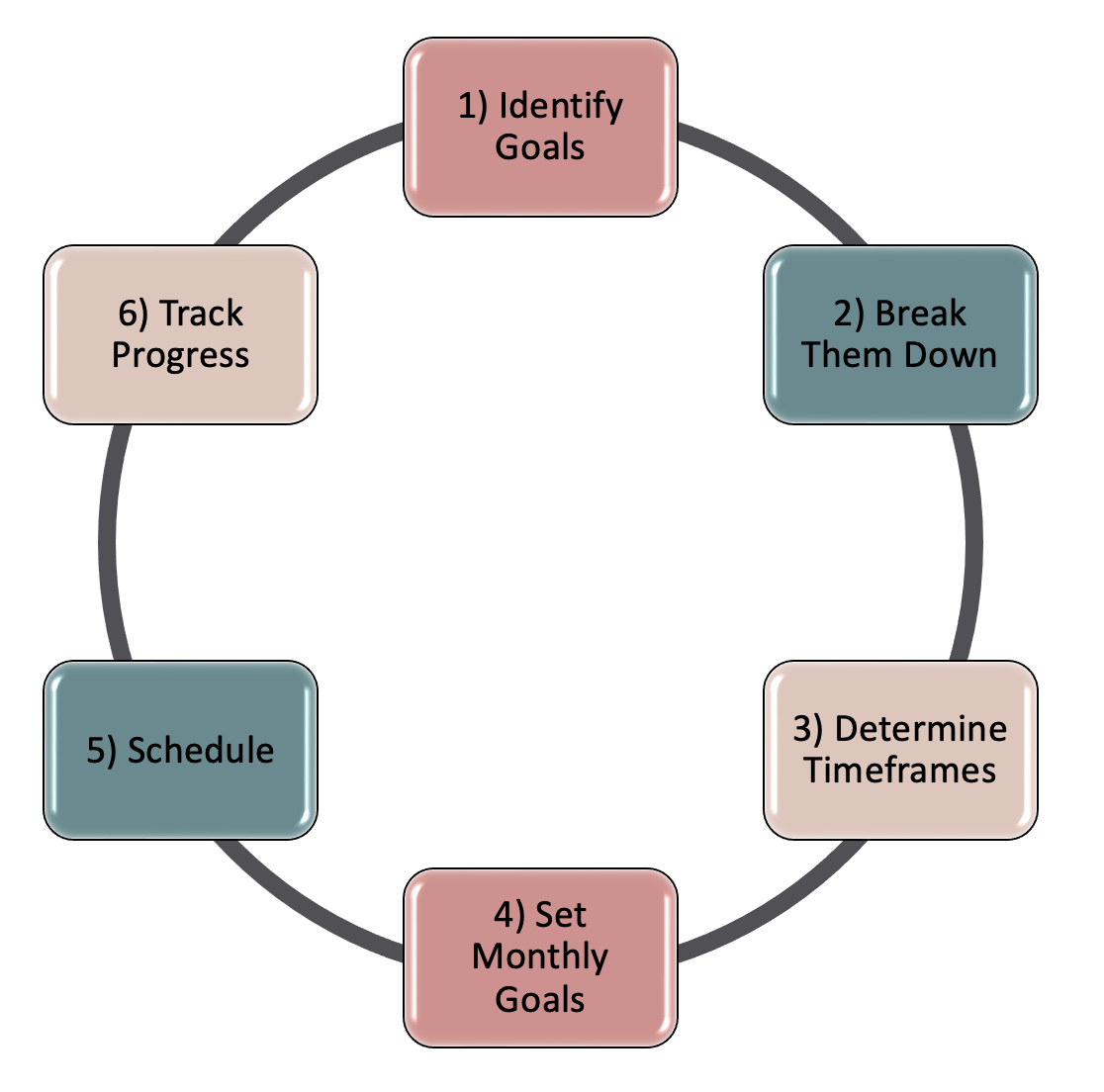Emerging Confidence Blog
Weekly inspiration to help you learn to trust yourself so you can build the life and career you want and earn the salary you deserve.

A Six-Step Guide to Setting, and Achieving, Goals That Really Matter
Goal setting is a powerful tool that can help you take control of your life and career, guiding you toward the future you envision. Whether you are in your mid-20s and just starting your professional journey or in your mid-50s and looking to redefine your career or personal aspirations, effective goal setting can be a game-changer. I’ve spent years identifying and redefining a process that works for me and have been able to boil it down to the six steps I'll share with you below.

Step 1: Identify Your Goals
The journey towards achieving your goals begins with a clear understanding of what you want to achieve. Makes sense, right? If you don’t know where you’re going, how will you know when you get there? The question I hear from so many of my clients is HOW do you set them? The answer is always, “It depends.”
For many of us in the workforce, our business goals are set for us—by the organization, our boss, or our department. And even if that’s true, you’re typically told what to do but not step-by-step how to achieve them. I often hear from my clients, “I have my performance review coming up this month, and I have to do a self-assessment of my accomplishments. I don’t remember what I did yesterday, let alone an entire year.”
Even if you have professional goals set for you, you more than likely have things you want to achieve in your personal life. Maybe it’s building a stronger relationship with your family members. Perhaps you want to focus on your health. There are “goal-setting experts” who will tell you not to set more than one to three goals, but I think you know your life better than anyone else including me. I have four high-level goals. One is to grow my business, and I have specific mini goals to get there. But another high-level goal is to improve my health. One of my mini goals is to drink 80 ounces of water a day. And guess what? I can drink water and grow my business at the same time!
But how do you identify what you want those goals to be? When I’m helping clients set goals, I find the Wheel of Life to be an excellent tool to help determine where you’re going and what big goals you want to focus on. It allows you to assess different aspects of your life, such as career, family, health, and personal development. By rating your satisfaction in each category, you can pinpoint areas that require improvement. This comprehensive perspective helps you identify both professional and personal goals.
If you’re interested in learning more about this, schedule a complimentary call here.
Step 2: Breaking Goals into Manageable Pieces
Goals often seem daunting when viewed in their entirety. Breaking them down into manageable pieces makes them more achievable. For this step, I find mind mapping to be incredibly helpful. Mind mapping is a creative and visual way to brainstorm and organize your thoughts. It's especially useful for breaking down broad goals into specific components. For instance, if your goal is career advancement, a mind map can help you outline the skills, certifications, or steps required to reach that goal.
Here's what that might look like.

You may have one large mind map or multiple ones, depending on what goals you’re setting.
Once you have your goals broken into smaller action steps, assign times to them. For example, in the mind map above, how long will it take you to research companies? Maybe finding your old resume will take 20 minutes, but researching common practices will take an hour because it’s been a while since you’ve done one. You want to determine how long each might take because you’ll be scheduling these tasks later.
Step 3: Determine Some Timeframes
Time management is crucial in the pursuit of your goals. While you can more than likely focus on some goals simultaneously, like my example of drinking water and growing my business, there are larger goals that will require focus. My goal to grow my business has a lot of components, and I know I can’t do them all at the same time. So, I’ve prioritized them so I can determine when to give them my full attention. For example, this quarter is when I’m focusing my attention on my infrastructure; my policies and procedures and technology.
Determine when you will focus on your goals by dividing them into quarterly and monthly objectives. Quarterly planning allows you to set the direction for your year, while monthly goals offer short-term targets. This structured approach keeps you on track without feeling overwhelmed.
Step 4: Set monthly Goals
Now we’re starting to get down to the nitty-gritty. Each month, it's essential to determine which of your goals is going to get your attention. Assess which of them you'll prioritize and what specific aspects you'll focus on. This monthly review ensures that your goals remain aligned with your current circumstances and aspirations. As you’re thinking about each of your bigger goals, consider what tasks you’ll need to complete to achieve the goal and how long each task might take you.
Step 5: Scheduling Your Goals
My mentor always says, “What gets scheduled gets done.” That is truth with a capital T! Scheduling your goals is a pivotal step in turning your dreams into reality. Make a conscious effort to allocate time for your goals in your calendar. By giving them dedicated time slots, you're making a commitment to yourself and your aspirations. Put them on your calendar like they were a meeting or appointment, and DON’T cancel them unless you absolutely HAVE to!
And here’s a word of warning. Don’t OVERschedule. I’ve been guilty of this in the past. I got so excited about all I could get done in one week and scheduled every waking hour. Guess what happened when an emergency popped up? My entire plan went down the drain, and with that came the guilt over not achieving what I set out to do.
Step 6: Tracking Progress
Finally, as you embark on your goal-setting journey, tracking your progress is key to staying motivated and accountable. Utilize various tools, such as apps, spreadsheets, or even a physical journal, to monitor how you're advancing toward your goals. Regularly assessing your progress allows you to make necessary adjustments and celebrate your achievements along the way.
Not only does this keep you on track, but come review time, it’s a great way to document all the accomplishments you’ve had throughout the year.
Conclusion
Goal setting is a transformative practice that empowers you to take charge of your life and career. By following this six-step process, you can identify, plan, and achieve your aspirations effectively. Whether your goals are career-focused, personal, or a blend of both, this method provides the structure and flexibility required to succeed. Embrace the power of goal setting and unlock your potential to achieve greatness. Remember, your journey begins with a single step, and each step brings you closer to the future you desire.
If you'd like one-on-one help with your goal setting, lets talk. Schedule a free call here.
emergingconfidence.com - All Rights Reserved - Terms & Conditions - Privacy Policy



